| M57 - The Ring
Nebula A,
Detailed Photos
B, Wide Angle Photos
A, Detailed Photos
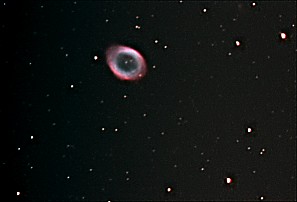
Click the
picture to see full resolution photo (0.96"/pixel). |
M57 (The Ring Nebula) 2.10.2002
(20:00 - 21:36 UT)
Resolution: 1.92 arcsec/pixel
Camera: Vesta 675 SC2
Telescope: 8" F6 OrionOptics Europa
Newtonian
Result focal ratio: F6
Exposure: 129x30s (gain 100%, Amp OFF, outdoor
white balance), 16xDF
Captured and processed by K3CCDTools, then in
Maxim DL Demo, IRIS and Corel PhotoPaint.
Seeing: very soft haze, lim.magnitude for naked
eye 4.2, temperature 10°C
This is the first light with my enhanced GEM1
mount (autoguided). I captured 175 frames AVI
and selected 129 best frames (74%) without sign
of periodic
error. Stars up to 18 mag are visible.
Better results should be achieved from not light
polluted city. Furthermore I am limited by a
viewport of my "balcony observatory". I
could start to take photos of M57 only when it
was only in 55° altitude. At the end of imaging
session it was only 34° above (light polluted)
horizon.
Processing details:
1, aligned and summed in K3CCDTools, then
exported to FIT
2, histogram stretching in Maxim DL Demo
3, low end histogram cut for R channel in IRIS
4, Richardson-Lucy deconvolution for each R-G-B
channel in IRIS
5, combining R-G-B plates into TrueColor bitmap
in IRISStars up to magnitude 18 were detected.
Even IC1296
spiral galaxy (14.8mag) was captured.
More detailed info about imaging this photo
you can find here: M57 (2.10.2002)
processing details
Look here for
M57 surroundings
maps and star data catalogue.
|
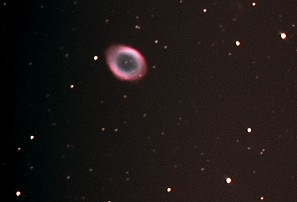
Click the
picture to see full resolution photo (0.96"/pixel). |
The same source as above, but
another (simplier) postprocessing: 1, aligned
and summed in K3CCDTools, then exported to FIT
2, histogram stretching in Maxim DL Demo
3, cutted red channel's low end of histogram (light
pollution) in Corel PhotoPaint
4, adaptive unsharp mask (66%) in Corel
PhotoPaint
More detailed info about imaging this photo
you can find here: M57 (2.10.2002)
processing details
Look here for
M57 surroundings
maps and star data catalogue.
|
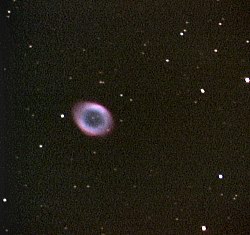
Click the
picture to see full resolution photo (0.96"/pixel). |
M57 (The Ring Nebula) 25.08.2002
(24.08.2002, 22:19 - 23:28 UT)
Resolution: 1.92 arcsec/pixel
Camera: Vesta 675 SC2
Telescope: 8" F6 OrionOptics Europa
Newtonian
Result focal ratio: F6
Exposure: 45x20s (gain 100%, Amp OFF), 15xDF
Captured and processed by K3CCDTools, then in
Maxim DL Demo and Corel PhotoPaint.
Seeing: hazy, almost full Moon, lim.magnitude for
naked eye 3.8, temperature 17°C
Although conditions were not very good, I
couldn't resist to capture M57. I captured 187
frames AVI and selected 45 best frames (24%)
without sign of periodic
error. Stars up to17 mag are visible.
Processing details:
1, aligned and summed in K3CCDTools, then
exported to FIT
2, gamma 1.25 in Maxim DL Demo(value 0.8),
histogram stretching
3, color tone corrections + flatten background in
Maxim DL
4, brightness-contrast-intensity and noise
reduction in Corel PhotoPaint
Look here for
M57 surroundings
maps and star data catalogue. |
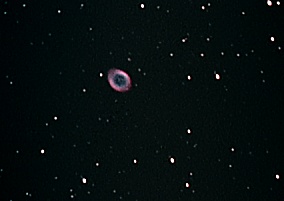
You can see
the full size (2.09"/pixel) here. |
M57 (The Ring Nebula) 10.11.2001
(20:07 - 20:34 UT)
Resolution: 3.14 arcsec/pixel
Camera: Vesta 675SC + 0.6FR
Telescope: 8" F6 OrionOptics Europa
Newtonian
Result focal ratio: F3.6
Exposure: 31x20s (gain 80%), 36xDF
Seeing: lim.magnitude for naked eye 4.5,
temperature 1°C
The focal reducer is a great thing! Better
exposure and better tracking. Stars up to17 mag
are visible.
Look here for
M57 surroundings
maps and star data catalogue. |
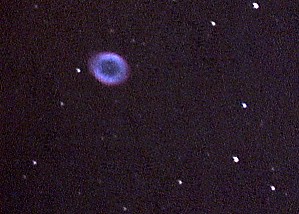
Place mouse
pointer above the photo to see the labels. |
M57 (The Ring Nebula) 14.10.2001
(19:59 UT)
Resolution: 1.92 arcsec/pixel
Camera: Vesta 675SC at prime focus
Telescope: 8" OrionOptics Europa Newtonian
Exposure: 9x20s (gain 80%), 10xDF
Seeing: very light fog, lim.magnitude for naked
eye 4.5
The same night as above, but another exposure
time was selected. 20s exposure time seems to be
maximum for Orion Europa GEM1 equatorial mount.
After seeking on Internet I managed to find very
good catalogue of the nearby stars around M57. I
think, that magnitude values are more exact. Look
here for M57 surroundings maps
and star data catalogue. Central star has 15.3mag.
According to this catalogue, the stars with 16.4mag
are in the limit of detection. It is stunning
fact, if you consider camera for 50$ and my
"urban balcony observatory". Thank you
very much, Steve.
See the more
details about processing. |

Place mouse
pointer above the photo to see the labels. |
M57
(The Ring Nebula) 14.10.2001 (19:05 UT)
Resolution: 1.92 arcsec/pixel
Camera: Vesta 675SC at prime focus
Telescope: 8" OrionOptics Europa Newtonian
Exposure: 46x6s (gain 100%), 60xDF
Seeing: very light fog, lim.magnitude for naked
eye 4.5The second attempt was more
successful. Better weather allowed to capture
stars fainter than 15 mag. The magnitude values
are from GSC (HST Guide Star Catalogue). The
stars with "?" were not present ind GSC.
Central star has (according to GSC) 14.7mag.
See the more
details about processing.
|
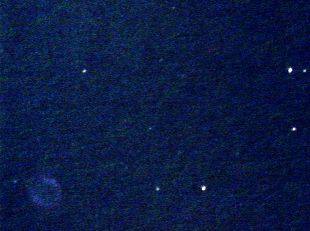
Place mouse
pointer above the photo to see the labels.
You can see the full size (0.96"/pixel) here. |
M57
(The Ring Nebula) 6.10.2001 (22:30 UT)
Resolution: 1.92 arcsec/pixel
Camera: Vesta 675SC at prime focus
Telescope: 8" OrionOptics Europa Newtonian
Exposure: 5x5s (gain 75%), 4xDF
Seeing: foggy, lim.magnitude for naked eye 2.8The first light
of Philips Vesta 675SC
This is my very first deep sky
photo in my life. The conditions were terrible -
very foggy, telescope not polar aligned. But I
was very eager to try my Vesta camera just
modificated for long exposures. I didn't see any
nebulae on my photos, so I decided to take a
photos at least the stars around the Ring nebula.
I couldn't use longer exposure because of poor
polar alignment. So I did a series of 5photos of
sky and 4 photos of dark frame. After processing
in my K3CCDTools, I
was very surprised, when I beheld the well-known
ring in the left bottom part of my images. I had
luck to capture the nebula into view angle of the
camera. It is humble photo, but I think , that it
is a good start point (the faintest star is 13
mag).
See the processing
procedure.
|
B, Wide Angle Photos
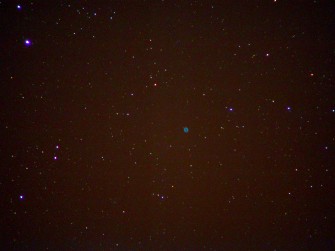
Click the
picture to see full resolution photo (1016x761
pixels, 4.74"/pixel). |
M57 (The Ring Nebula) 01.10.2002
(30.09.2002, 22:04 - 22:17 UT)
Resolution: 14.2 arcsec/pixel
Camera: Nikon
Coolpix 995, f=18.8mm
Telescope: 80mm F5 Refractor, 25mm eyepiece
afocal
Result focal length: 300.8mm (~37X Zoom)
Result focal ratio: F3.76
Exposure: 12x20s (ISO800, incadescent -3), Noise
Reduction
Camera control: The
Force software
Processed by K3CCDTools,
then in Corel PhotoPaint.
Seeing: nice clear skies (in light poluted city),
but windy,
lim.magnitude for naked eye 4.5, temperature 11°C
This is my first session with Nikon digital
camera and afocal projection. Stars up to13.5 mag
are visible (in full size photo and correctly calibrated
monitor). The field of view is almost 1.5°.
Color of the nebula is not very nice, because I
used Incadescent white balance. The image is
without flat field correction.
Processing details:
1, aligned and summed in K3CCDTools
2, gamma 1.5 in K3CCDTools
3, resized to 50% in Corel PhotoPaint, 60%
adaptive unsharp mask
4, brightness-contrast-intensity in Corel
PhotoPaint |
Back to Messier
Catalog
Computer generated images,
real images, drawings and texts are property of the
author and may not be reproduced or used without
permission of author.

Last Update:
01.10.2002
|